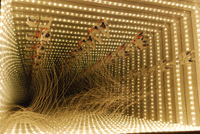Two EVL Grad Students Win UIC Image of Research Award
March 27th, 2008
Categories: Animation, Applications, Devices, MFA Thesis, MS / PhD Thesis, Multimedia, Visualization

About
Two EVL Graduate Students have won awards in the 1st Annual The Image of Research Exhibit Competition at UIC.
EVL MFA student AnnMarie Cernoch has been awarded First Prize and EVL MS student Dmitri Svistula has been awarded Third Prize.
AnnMarie Cernoch’s statement about her research and the winning image:
“The idea of infinity is a personal belief. Using my own beliefs and research on ways to visualize the concept of infinity; I have created an intimate atmosphere of robotic creatures which move through an illusion of infinite space. For me, infinity is an illusion of the mind and spirit.
The video documentation of this project is currently being displayed on an ultra high-resolution 4K tiled display system at the Electronic Visualization Laboratory. This extremely high resolution is the future of digital imaging. The higher a display’s pixel count is, the better the image resolution can be. This enables the digital imagery to be displayed with all available data originally captured.”
Dmitri Svistula’s statement about his research and the winning image:
“The image represents a visualization of water flow for an area around Mariner Valley on Mars using Rain Table.
Rain Table software allows users to interactively explore the flow of water across arbitrary digital maps and discover the concepts of watersheds, floods, and the interconnectivity of river systems. Users position tracked pucks over areas to indicate the location, or locations, of rainfall, as several people can cooperatively interact with the system at once.
Rain Table technology consists of a 7-by-3-foot, 24-Megapixel display table, built using six Dell LCD 2560x1600 displays, driven by a cluster of 6 computers. Six infrared cameras, mounted overhead, determine the location of the pucks on the table. The image shows four screens of the digital table shot from overhead while several users interact with it.”